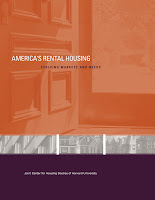This week, the Joint Center for Housing Studies (JCHS) released a report on the state of rental housing in the U.S. A major headline from the report is that the number of cost-burdened renters has  reached an all-time high. More than half of all renters spend more than 30 percent of their income on rent, and 28 percent are severely cost burdened, spending more than half of their incomes on rent. The rental population is growing—both as a result of demographic and economic factors—and the rising affordability challenges and increasing rental supply gap are critical problems, particularly in this era of declining federal resources.
reached an all-time high. More than half of all renters spend more than 30 percent of their income on rent, and 28 percent are severely cost burdened, spending more than half of their incomes on rent. The rental population is growing—both as a result of demographic and economic factors—and the rising affordability challenges and increasing rental supply gap are critical problems, particularly in this era of declining federal resources.
The JCHS analysis includes an abundance of data and concise summaries of key policy issues related to the rental housing market. In addition, the report describes the situations of renter households and the conditions of the housing market from a variety of perspectives, and some of the less common storylines are particularly beneficial for expanding the dialogue around housing needs.
When households have to spend more on rent, they spend less on other necessities. Low-income households that have to spend more on rent spend less on food, health care, transportation and savings, among other things. Having to choose between food and rent or health care and rent is a devastating choice and these tradeoffs compound the stress and instability many severely cost-burdened households experience every day. And the inability to save for retirement or even for “life happens” emergencies undercuts the opportunities for building economic security. The JCHS report did not specifically mention child care, but in some parts of the country, child care for two children can cost just as much as rent and can be an additional hurdle for lower-income working families. A recent analysis of housing costs and household budgets for low- and moderate-income families in Arlington County, Virginia highlights these cost pressures.
When households spend a disproportionately high share of the income on rent, they have little left for necessities and their quality of life of suffers. Furthermore, when they have to spend a greater share of their income on rent, they also have less to less to spend on other non-essential goods and services, which means that the local economy can also feel an impact.
The challenge to find affordable housing is a problem for households along much of the income spectrum. Over 80 percent of very low-income households (those with incomes below $15,000) spend more than 30 percent of their income on rent. However, affordability problems among higher-income households have increased dramatically. For example, according to the JCHS report, the share of cost-burdened households with incomes between $45,000 and $74,999 nearly doubled between 2001 and 2011. Even when working full-time, many renters still face affordability challenges. Nearly 40 percent of renters with a full-time job spend more than 30 percent of their income on rent.
When higher-income households face affordability challenges, they put even more pressure on the availability of housing affordable to lower-income renters. A recent Atlantic Cities article provides a good summary of how middle-class households have crowded out lower-income households from the more affordable housing stock.
Despite the recent surge in multifamily construction, the concerns about overbuilding are generally misplaced. During the recession, residential construction activity slowed to a crawl. In 2009, there were only 109,000 new multifamily housing starts, compared to well over 300,000 each year in the decade prior. By 2013, the number of new multifamily starts will have increased to about 294,000 on an annualized basis. In some fast-growing metropolitan areas, new multifamily rental buildings have been going up seemingly non-stop. This acceleration of building activity has some concerned about an oversupply of multifamily rental housing. However, as the JCHS report points out, the renter population has grown much faster than the supply of rental housing, and future rental demand will remain high. Furthermore, rent levels continue to increase and vacancy rates continue to be low. Therefore, by these measures, there seems little evidence that we are overbuilding.
However, there is some evidence that multifamily rental housing is not always being built in the most appropriate locations. The suburbs continue to attract more and more jobs; however, in many suburban communities, zoning ordinances prohibit the construction of multifamily housing, even in areas close to job centers. Concentrating multifamily housing near transit has also been shown to have substantial benefits to households and communities, but many transit projects are developed, designed and funded without consideration of the inclusion of multifamily, or in particular affordable, housing in the plans.
During the recent increase in multifamily housing construction activity, many developers have focused on the higher end of the market, with a substantial share of luxury apartments with amenities designed for high-income young professionals. The rate at which high-end rental housing is being built outpaces the pace at which slightly older housing can trickle down to more affordable price points. So low- and moderate-income renters have not benefited from the current supply surge in most markets.
We hear often about the affordability challenges of renters. The problem is not going away and, in fact, is getting worse by most measures. But because the same kinds of numbers about cost-burdened households are reported often, some people tend to tune them out. Different storylines, different perspectives can help underscore the importance of rental housing and broaden the base for dialogue about housing affordability challenges.

